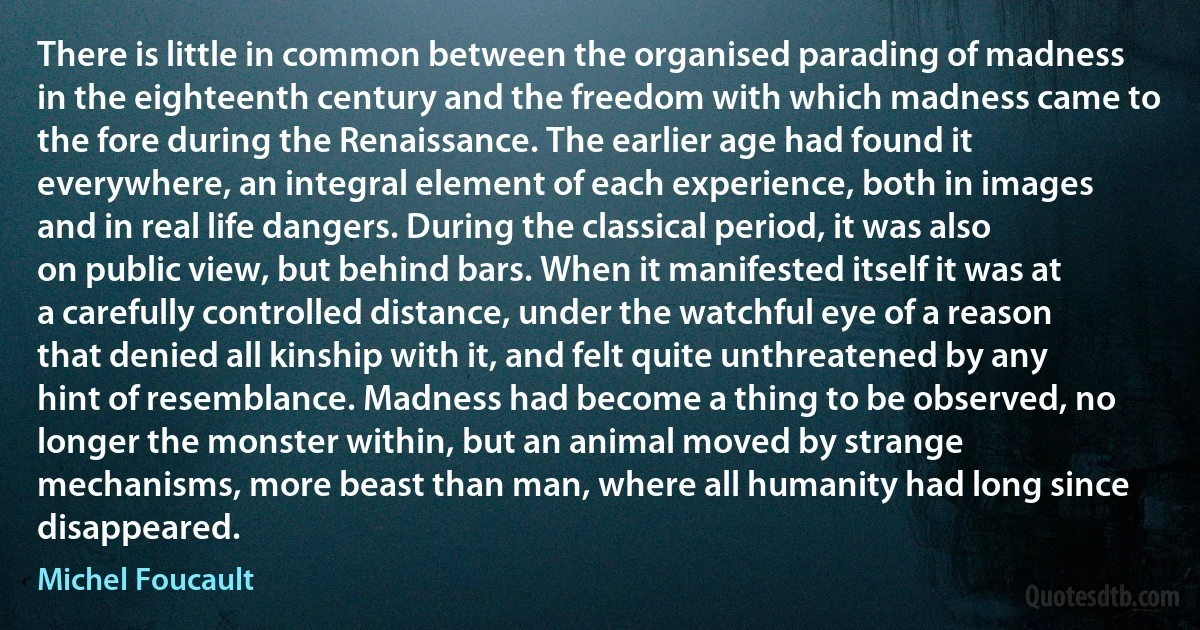
There is little in common between the organised parading of madness in the eighteenth century and the freedom with which madness came to the fore during the Renaissance. The earlier age had found it everywhere, an integral element of each experience, both in images and in real life dangers. During the classical period, it was also on public view, but behind bars. When it manifested itself it was at a carefully controlled distance, under the watchful eye of a reason that denied all kinship with it, and felt quite unthreatened by any hint of resemblance. Madness had become a thing to be observed, no longer the monster within, but an animal moved by strange mechanisms, more beast than man, where all humanity had long since disappeared.
Michel FoucaultRelated topics
age animal beast behind came century classical common control distance early eighteenth element experience eye felt found freedom integral life longer madness man monster parading public quite real reason renaissance strange thing under viewRelated quotes
In Maximus all the streams of the Greek patristic tradition flow together in synthesis. At the same time, with real originality, there is much from within that tradition that he takes to a higher level. But the course of this saint's life impressed me even more than his teaching. Once again, like Athanasius, one man was able to defend orthodox Christology against a whole empire. A Byzantine joins forces with Pope St. Martin I in Rome and finally suffers martyrdom for the true faith. This is the summit of that unity of doctrine and life which marks the whole patristic age; speculation and mysticism of the greatest subtlety are wedded to a soberly and consciously grasped martyrdom. In St. Maximus we can see in the Catholica what Kierkegaard found within the individual.

Hans Urs von Balthasar
I was a Yorkshire miner's son, the youngest of seven, and my mother was no longer so very young. She suffered from bad rheumatism in the back and would often say to me in winter, when I came home from school: 'Henry, boy, come and rub my back.' Then I would massage her back with liniment. When I came to model this figure [for his sculpture 'Seated Woman', 1957] which represents a fully mature woman, I found that I was unconsciously giving to its back the long-forgotten shape of the one that I had so often rubbed as a boy. Not just her shoulder but her whole back down from the shoulder blades with the skin close to the bone, to the fleshy lower parts. I had a strong sense of contrast between bone and flesh. I was seven or eight at the time [c. 1906].

Henry Moore
Well, I want to start out that I was lucky in the ‘60s to also be taking a class in Classical Ethology by a professor named Tom Evans, where I learned that operant conditioning does not explain all animal behavior. He explained how fixed action patterns and hardwired instinctual behavior works. And I remember going on a visit to Dr. Skinner and I felt like I was visiting, you know, the grand temple of psychology. And I went up to his office and, you know, he seemed, I'm like, "oh, you mean he's actually an ordinary person?" And we got to talking and of course back then I wore a dress you know ‘cause, you know, ladies had to be, like, dressed up, and I had a very conservative dress on, and B. F. Skinner touched my legs.

Temple Grandin
After all human beings have to live dogs too so as not to know that time is passing, that is the whole business of living to go on so they will not know that time is passing, that is why they get drunk that is why they like to go to war, during a war there is the most complete absence of the sense that time is passing a year of war lasts so much longer than any other year. After all that is what life is and that is the reason there is no Utopia, little or big young or old dog or man everybody wants every minute so filled that they are not conscious of that minute passing. It's just as well they do not think about it you have to be a genius to live in it and know it to exist in it and express it to accept it and deny it by creating it.

Gertrude Stein
Right after the Flood, as all of the water went down, all of the decayed plant matter would have made the water very high in minerals and decayed plant and animal life would have been high in nutrients to make anything to grow. Food would have been readily available with all of the rotting carcasses of the vegetation and the animals. The coral could have grown much faster under these conditions, then it would have slowed down to its current rate. People who have studied coral reefs say that they could have been formed in four to five thousand years with no problem. If the earth is older than that, why aren't the the coral reefs much larger? Their rate of growth indicates a young age for the earth.

Kent Hovind
